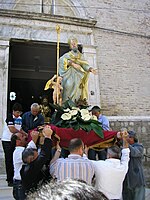
Athanasius of Alexandria
Athanasius I of Alexandria[note 1] (c. 296–298 – 2 May 373), also called Athanasius the Great, Athanasius the Confessor, or, among Coptic Christians, Athanasius the Apostolic, was a Christian theologian and the 20th patriarch of Alexandria (as Athanasius I). His intermittent episcopacy spanned 45 years (c. 8 June 328 – 2 May 373), of which over 17 encompassed five exiles, when he was replaced on the order of four different Roman emperors. Athanasius was a Church Father,[3] the chief proponent of Nicene theology against the anti-Nicenes,[4] and a noted Egyptian Christian leader of the fourth century.
"Athanasius" redirects here. For other people named Athanasius or Athanasios, see Athanasius (given name).
Athanasius of Alexandria
c. 296–298
2 May 373 (aged 75–77)
Alexandria, Roman Egypt
Philosophy career
Pope of Alexandria
- First Letters to Serapion
- Life of Antony
- On the Incarnation
- Nicene Christianity
- Trinitarianism
- 7 Pashons (Coptic Christianity)
- 2 May (Western Christianity)
- 18 January (Byzantine Christianity)
Church of San Zaccaria in Venice, Italy, and Saint Mark's Coptic Orthodox Cathedral in Cairo, Egypt
Conflict with the Eusebians,[5] as well as with successive Roman emperors, shaped Athanasius' career. In 325, at age 27, Athanasius began his leading role against the Arians as a deacon and assistant to Bishop Alexander of Alexandria. He did not yet play an important role at the First Council of Nicaea.[6] Roman Emperor Constantine the Great had convened the council in May–August 325 to heal the division in the church caused by the dispute between Alexander and Arius.[7] Three years after that council, Athanasius succeeded his mentor as Patriarch of Alexandria. In addition to the conflict with the Eusebians (including powerful and influential churchmen led by Eusebius of Nicomedia), he struggled against the Emperors Constantine, Constantius II, Julian the Apostate and Valens. He was known as Athanasius Contra Mundum (Latin for 'Athanasius Against the World'). At the Council of Tyre in 335, he was condemned and exiled for violence against the Melitians in his see.
Nonetheless, within a few years of his death, Gregory of Nazianzus called him the "Pillar of the Church". His writings were well regarded by subsequent Church fathers in the West and the East, who noted their devotion to the Word-become-man, pastoral concern and interest in monasticism. Athanasius is considered one of the four great Eastern Doctors of the Church in the Catholic Church.[8] Some argue that, in his Easter letter of 367, Athanasius was the first person to list the 27 books of the New Testament canon that are in use today.[9] Others argue that Origen of Alexandria was the first to list the twenty-seven books of the New Testament in his Homilies on Joshua (only there is a textual variant as to whether or not he included Revelation).[10][11] Athanasius is venerated as a saint in the Eastern Orthodox Church,[12] the Catholic Church,[13] the Coptic Orthodox Church, the Anglican Communion, and Lutheranism.
Papal styles of
Pope Athanasius I
During the Arian Controversy, Athanasius was the main defender of the Nicene Creed and the term homoousios. He presented himself as the preserver of scriptural orthodoxy. Athanasius was a one-hypostasis theologian, meaning that Father, Son, and Holy Spirit are a single Person with a single Mind:
Following Origen, the Eusebians taught that Father, Son, and Holy Spirit are three distinct hypostases (Persons). In contrast, consistent with the idea that the Son is part of the Father, Athanasius believed that Father and Son are a single hypostasis (a single Person).[60][61][62]
Athanasius' insistence on a single hypostasis in God is further illustrated by his opposition to the idea that the Logos is the Mediator between God and creation. Athanasius rejected the idea of the pre-existent Logos as Mediator between God and creation.[64][65] Since he did not recognize the Logos as a distinct hypostasis, he limited Christ’s role as Mediator to the incarnation.[66][67] Therefore, Athanasius had a 'unitarian' theology, similar to the Sabellians.
Ayres describes both Athanasius’ and Marcellus’ Sabellian theologies as “unitarian.”[68][69]
Eschatology[edit]
Based on his understanding of the prophecies of Daniel and the Book of Revelation, Athanasius described Jesus’ Second Coming in the clouds of heaven and pleads with his readers to be ready for that day, at which time Jesus would judge the earth, raise the dead, cast out the wicked, and establish his kingdom. Athanasius also argued that the date of Jesus’ earthly sojourn was divinely foretold beyond refutation by the seventy weeks prophecy of Daniel 9.[70]
Athanasius was originally buried in Alexandria, but his remains were later transferred to the Chiesa di San Zaccaria in Venice, Italy. During Pope Shenouda III's visit to Rome (4–10 May 1973), Pope Paul VI gave the Coptic Patriarch a relic of Athanasius,[71] which he brought back to Egypt on 15 May.[72] The relic is currently preserved under the new Saint Mark's Coptic Orthodox Cathedral in Cairo. However, the majority of Athanasius's corpse remains in the Venetian church.[73]
All major Christian denominations which officially recognize saints venerate Athanasius. Western Christians observe his feast day on 2 May, the anniversary of his death. The Catholic Church considers Athanasius a Doctor of the Church.[8] For Coptic Christians, his feast day is Pashons 7 (now circa 15 May). Eastern Orthodox liturgical calendars remember Athanasius on 18 January.[74] Athanasius is honored on the liturgical calendars of the Church of England and the Episcopal Church on 2 May.[75][76] Gregory of Nazianzus (330–390, also a Doctor of the Church), said: "When I praise Athanasius, virtue itself is my theme: for I name every virtue as often as I mention him who was possessed of all virtues. He was the true pillar of the Church. His life and conduct were the rule of bishops, and his doctrine the rule of the orthodox faith."[18]


